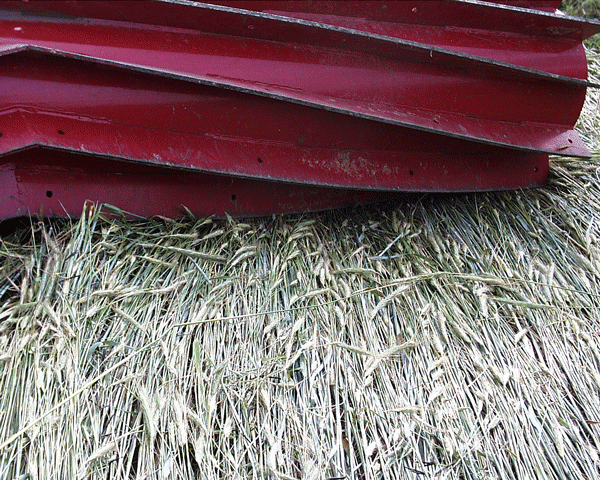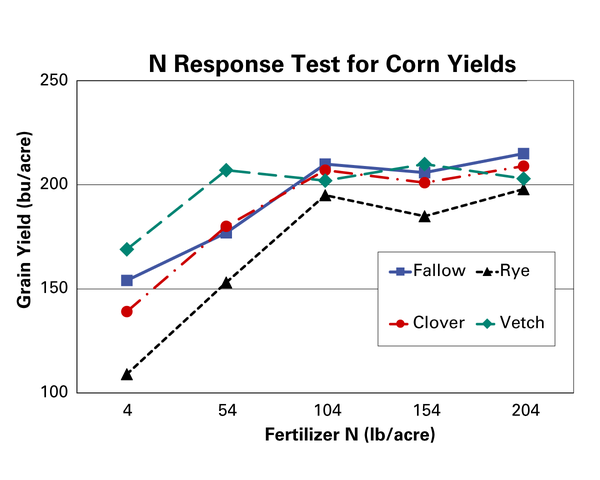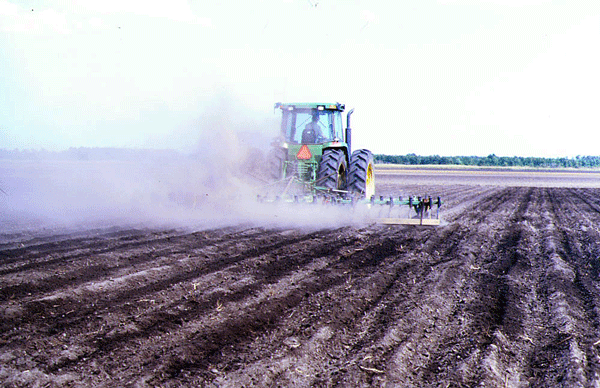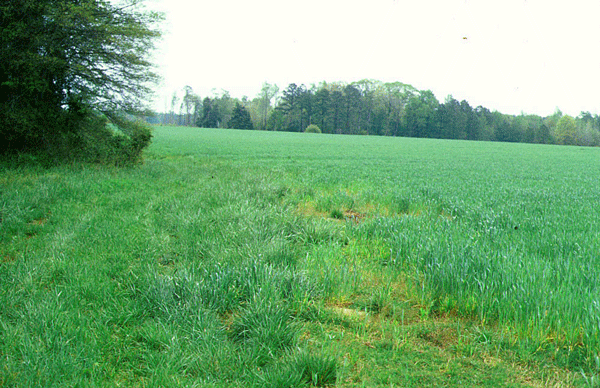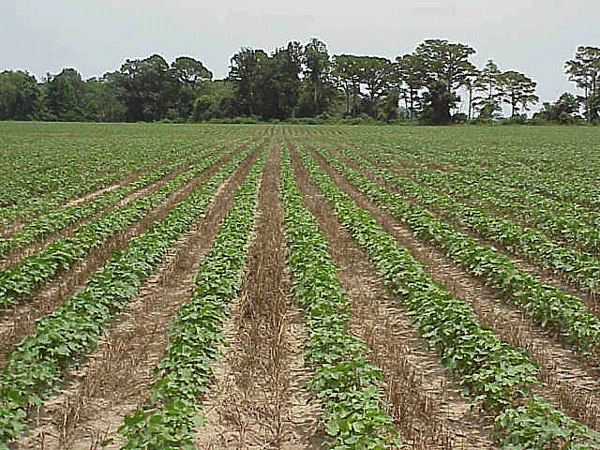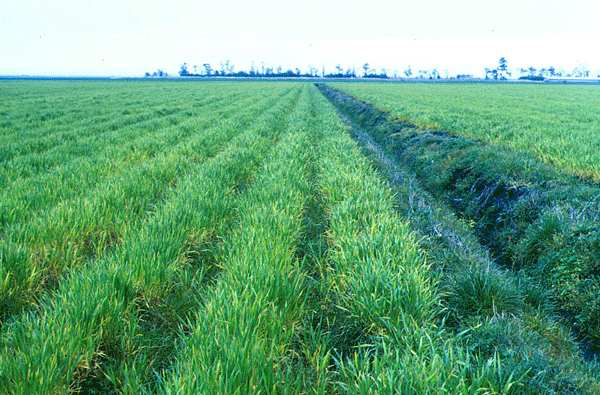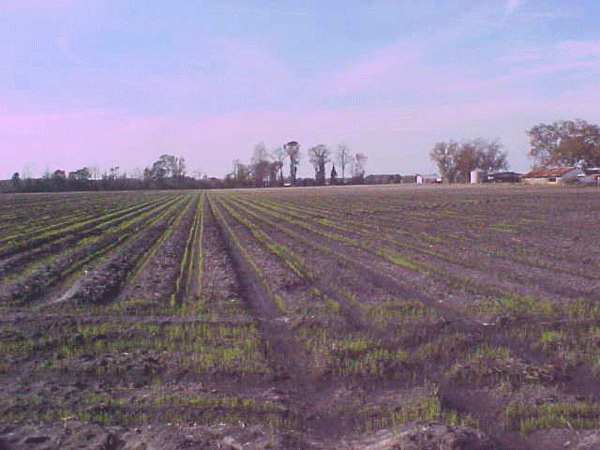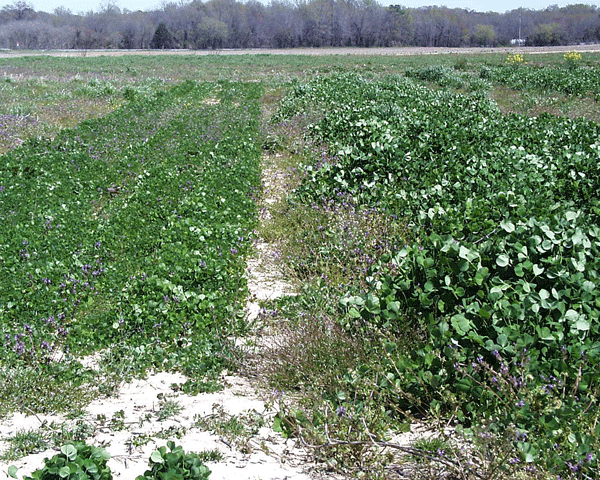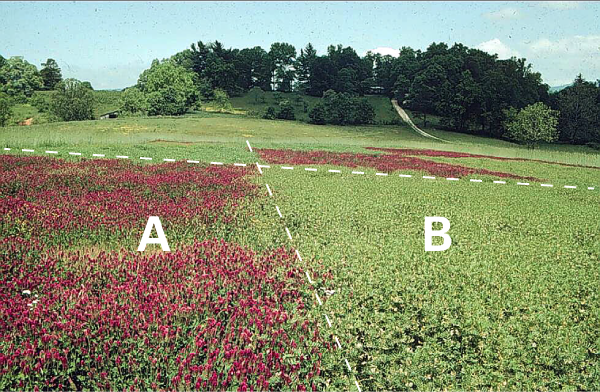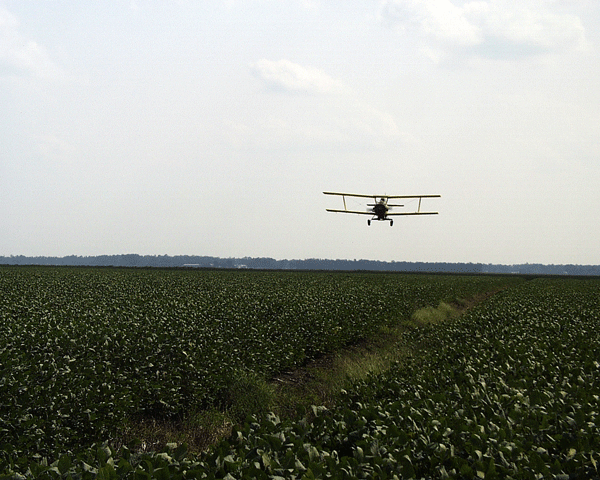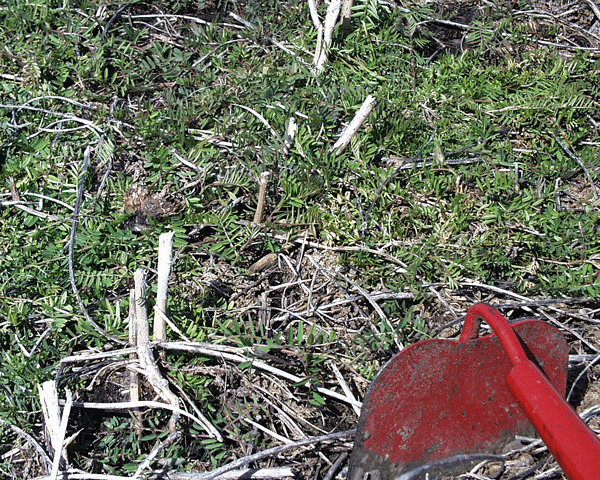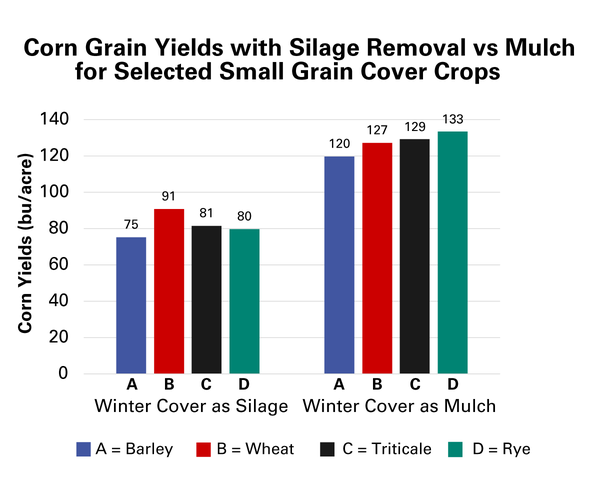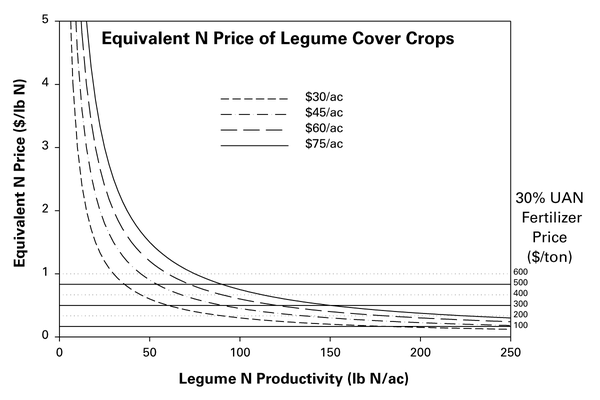Introduction
Winter annual cover crops have been used in rotation with summer crops for many years in North Carolina, but now there are some interesting new applications for this practice. Early experiments dating from the 1940s showed several important benefits of planting winter annual cover crops, chief among them erosion control, addition of nitrogen (N) to the soil for use by a subsequent crop, removal of N from the soil to prevent nutrient loading, and buildup of residue that acts as a mulch for water conservation or retention. Increased soil organic matter provided by cover crops has been demonstrated in some regions, but this outcome is less likely in the warm, humid conditions of the southeastern United States. Researchers documented no increase in soil organic matter resulting from cover crops planted in long-term trials (>40 years) from western Tennessee (Jagadamma et al. 2019).
Generally, winter cover crops are planted in early fall and allowed to grow over the winter until early spring, when their growth is terminated by herbicide treatment or plowing. In conservation tillage systems, the residue from the cover crop is not plowed under after the herbicide treatment and remains on the surface as mulch (Figure 1). A newly developed alternative for certified organic farms provides similar residue conservation without herbicides; it achieves cover crop termination using a roller-crimper (Figure 2).
Winter annual cover crops are usually legumes or cereals but can include brassicas. The legumes best adapted to North Carolina soil and climatic conditions are crimson clover, hairy vetch, Austrian winter pea, and Cahaba white vetch. Recent trials have also included lupines, berseem clover, subterranean clover, and other legumes. Cereals or small grains that are best for North Carolina are rye, wheat, barley, triticale, and oats. Descriptions of many potential cover crop species can be found in the United States Department of Agriculture publication Managing Cover Crops Profitably.
Benefits of Cover Crops
Legume cover crops may contribute N to a subsequent crop, relieving the farmer of some of the cost of buying fertilizer. Legumes can supply much of the N required for many summer crops, from row crops such as corn or grain sorghum to vegetables such as sweet corn, cabbage, squash, and pumpkins. Figure 3 shows that maximum corn yield was attained with both 104 lb fertilizer N/acre (rye and clover cover crops and fallow) and 54 lb fertilizer N/acre (vetch cover crop); thus, vetch appears to supply the equivalent of 50 lb N/acre, whereas rye and clover cover crops and the fallow system required about twice the amount of N fertilizer.
Small grains and other grasses help control erosion caused by wind (Figure 4) or water (Figure 5). Erosion due to wind and water is much greater on bare ground than on a surface protected by a cover crop. Cover crops in a conservation tillage planting system provide erosion control during the winter while the plant is growing (Figure 6) and mulch for the soil surface during the summer in the form of crop residue (Figure 7). This surface mulch enhances summer rainfall infiltration, reduces soil water evaporation, and provides weed control via early shading. All these potential benefits are highly dependent on weather and management factors that should be considered when using cover crops. In contrast to legumes, grass cover crops can immobilize soil N as they decompose. Thus, they can reduce crop growth unless sufficient inorganic N is applied (Figure 3).
Management decisions, such as the date and method of planting and killing a cover crop, influence the amount of cover crop growth and nutrient uptake, as well as the availability of the nutrients released to a following crop through decomposition. Plowing cover crops under early in the spring will increase the decomposition rate of the cover crop, but this early termination also limits cover crop growth, which limits nutrient accumulation and the buildup of soil organic matter from the residue. Allowing the cover crop to grow until later in the spring will improve nutrient accumulation in the cover biomass, but it may reduce the ability of microbes to decompose residues for short-term use. Leaving the cover crop on the surface also reduces its decomposition rate compared to plowing. This extra surface residue accumulation may benefit subsequent crops, but it should be evaluated to determine whether it inhibits crop growth or encourages pests or diseases.
Cover crops in the coastal plain and tidewater regions of eastern North Carolina are used primarily for controlling wind erosion and promoting soil moisture retention. Wind erosion can be severe in cultivated organic and sandy soils of this region (Figure 4). Seedlings are especially vulnerable to damage from sandblasting during cool, dry springs, when growth rates are slow. Many farmers use small grain cover crops to control erosion due to the amount of biomass produced. There are many combinations of cover crops and planting techniques to choose from: using winter wheat or cereal rye; planting flat or on beds (Figure 8); and planting the following crop using no-till, strip-till, or conventional till. Strip plantings of cereal rye can also be used as windbreaks to protect vegetable crops and tobacco from wind erosion (Figure 9).
The extent of soil erosion control provided by cover crops during the fall, winter, and early spring depends largely on when the crop is established (Figure 10). Timing is particularly important with legumes because late seeding results in small plants with limited root systems. If the legume cover crop is established early enough, adequate growth in the fall can help minimize soil erosion. The nonlegumes rye and triticale provide maximum erosion protection during fall and winter because of their rapid growth rates. Active cover crop growth in the spring, before the summer crop is planted, offers continued erosion control compared to bare ground.
Legume Cover Crop Establishment
Although crimson clover, hairy vetch, Austrian winter pea, and common vetch are widely adapted to soil and climatic conditions in North Carolina, they have some limitations. Hairy vetch tends to be more winter hardy than the others and generally can be planted later. Crimson clover grows faster in the spring, thereby maturing and obtaining peak dry matter production about three to four weeks ahead of hairy vetch. Hairy vetch is better adapted to more sandy soils and to more poorly drained soils than crimson clover, although crimson clover provides adequate dry matter production on most well-drained sandy loams. The erect growth habit of crimson clover may make it slightly easier to manage than hairy vetch, which has a viny nature (Figure 11).
The following general cultural practices are applicable to all legume cover crops.
Planting dates. A wide range of planting dates exists for most legumes (Table 1), although early planting obtains the best results. Early seeding dates are easy to meet with legume cover crops following tobacco, corn silage, spring vegetables or, in eastern North Carolina, grain corn. Unless an early maturing soybean is planted, soybean harvest is usually late enough to make cover crop establishment difficult prior to the onset of winter (unless aerially overseeded, which is discussed later). Because Cahaba white vetch is not very winter hardy, it is not adapted to the western regions of the state. Freeze damage has also occurred with Austrian winter pea at high elevations (above 2,500 feet). In general, planting late (late October to November) in the piedmont and mountains will increase the risk of winter kill.
|
Region |
Crimson Clover |
Hairy Vetch |
Austrian Winter Pea |
Cahaba White Vetch |
|
Mountains |
August 10 to September 15 |
Not adapted |
||
|
Piedmont |
August 25 to October 1 |
August 25 to October 15 |
August 25 to October 1 |
Not adapted |
|
Coastal plain |
Preferred dates: September 1 to September 30 Possible dates: September 1 to October 30 |
|||
Seeding rate, depth, and method. Seeding rates and depths vary with legume species (Table 2). Seed crimson clover at 20 to 25 lb/acre broadcast and 15 to 20 lb/acre drilled. For both hairy vetch and Cahaba white vetch, the rates are 20 to 30 lb/acre broadcast and 15 to 20 lb/acre drilled. For Austrian winter pea, the rates are 25 to 35 lb/acre broadcast and 20 to 25 lb/acre drilled.
|
Legume |
Seeding Rate (lb/acre) |
Seeding Depth (inches) |
|
|
Broadcast |
Drilled |
||
|
Crimson clover |
10 – 15 |
5 – 10 |
1⁄4 – 1⁄2 |
|
Hairy vetch |
10 – 15 |
5 – 10 |
1⁄2 – 11⁄2 |
|
Cahaba white vetch |
20 – 30 |
15 – 20 |
1⁄2 – 11⁄2 |
|
Austrian winter pea |
25 – 35 |
20 – 25 |
3⁄4 – 11⁄2 |
Use shallow planting depths for finer-textured, clayey soils and deeper depths for coarse-textured, sandy soils. Drilling into a conventional seedbed is the most reliable way to obtain a uniform stand; however, a no-till grain drill also can be used successfully, provided that residue from the previous crop is not excessive and soil moisture is sufficient to allow the drill to penetrate to the desired planting depth. Seeds may be broadcast if the soil has been disked and partially smoothed. Cultipacking after broadcasting will encourage good seed-to-soil contact. Crimson clover, in particular, can be established easily with this method.
An innovative system that has shown promise in other southeastern states is to allow crimson clover to reseed itself naturally. This method will work in North Carolina where the following crop is midsummer vegetable crops (pumpkins), grain sorghum, or tropical silage corn (late spring establishment). Reseeding usually will not work for crimson clover planted before full-season field corn because crimson clover seed matures after corn planting dates. With careful management, this system can work for full-season, no-till corn if strips of crimson clover are allowed to mature, produce, and disperse seed (as discussed in the economics section).
Aerial overseeding into cotton at defoliation or into soybean prior to leaf drop has been successful in some cases (Figure 12 and Figure 13). Overseeding can prevent the reduced productivity that might result if planting is delayed until after harvest of certain crops (Table 3).
|
Prior Soybean Maturity Group |
Seeding Method |
Seeding Date |
Dry Matter (ton/acre) |
N (lb N/acre) |
|
|
2006 |
2007 |
||||
|
3 |
Drill after harvest |
October 12 |
October 9 |
1.5 |
88 |
|
4 |
Aerial overseed |
September 8 |
August 21 |
1.3 |
79 |
|
4 |
Drill after harvest |
October 12 |
October 9 |
1.5 |
92 |
|
5 |
Aerial overseed |
September 8 |
September 19 |
1.5 |
85 |
|
5 |
Drill after harvest |
November 19 |
November 21 |
0.4* |
32* |
|
* Dry matter and N accumulation were significantly reduced if planting was delayed until November following harvest of a maturity group 5 soybean (P<0.05). |
|||||
Grazing or hay crop. Winter annual legumes can be grazed or cut for hay before the summer crop is planted. However, either of these practices would remove most of the N and mulch from the system because N is concentrated in the top growth. Legumes grow only a limited amount during fall and winter, which makes them a poor choice for grazing during this period. If grazing continues too long in the spring, growers may find that the rough soil conditions caused by hoof traffic lessen the benefits they expected from spring no-till management.
Small Grains Cover Crop Establishment
Determine small grain lime and fertilizer needs based on soil test results. On coastal plain soils, supplemental N (25 to 35 lb/acre) may be needed to obtain adequate top growth. Successful establishment of small grain stands generally can be achieved by planting later than those for legumes, even as late as early December in coastal plain regions (Table 4); this allows establishment of the cover crop after a crop such as soybeans is harvested in late fall. Remember that late seeding dates may reduce some soil erosion protection. For sandier coastal plain soils, such as Wagram, Lucy, Kenansville, and Conetoe, rye is the preferred small grain cover crop. Seeding rates are 1 to 11⁄2 bushels per acre for rye, triticale, and wheat and 2 bushels per acre for oats. As previously discussed, seeding depth varies from 1⁄2 to 11⁄2 inches, depending on soil texture. Planting methods are the same as those described for legumes. Aerial seeding of rye into soybeans just before leaf drop has been marginally successful.
|
Location |
Rye |
Wheat |
Barley |
Triticale |
Oats |
|
Mountains |
Preferred dates: August 15 to September 30 Possible dates: August 15 to October 30 |
Not adapted |
|||
|
Piedmont |
Preferred dates: September 15 to October 15 Possible dates: September 15 to November 15 |
||||
|
Coastal plain |
Preferred dates: September 30 to November 15 Possible dates: September 30 to December 15 |
||||
Using a small grain cover crop for silage or hay will greatly delay corn planting and thereby increase the risks of drought, heat stress, and pests associated with late planting. In addition, the potential for conserving soil moisture may be reduced if the cover crop is removed for silage, leaving less mulch and reducing the subsequent corn yield (Figure 14).
Growers need to consider timing when planting winter wheat in locations where the Hessian fly is present. If Hessian fly is present in your area, plant wheat after the first fall frost. If small grain must be planted before frost, consider choosing small grain not inhabited by Hessian fly, which includes rye, triticale, barley, or oats.
Cover Crop Mixtures: Multiple Benefits
Two or more cover crop species can be combined in a single planting to realize the benefits of each. Generally, a grass species is combined with one or more legume species. For example, when cereal rye and hairy vetch are planted together, the rapid germination and early fall growth of cereal rye help stabilize the soil surface and allow the more fragile hairy vetch seedlings to thrive. The next spring, the cereal rye plants provide physical support for the climbing hairy vetch stems.
Another example of suitable mixtures would be wheat, triticale, or barley planted with crimson clover. All of these plants have similar heights, so deleterious shading would be minimal compared to co-planting of tall rye and short crimson clover.
In many areas of North Carolina, farmers increasingly must manage nutrients to protect surface waters from nutrient loading. Cereal rye planted early in the fall — alone or in mixtures — can greatly reduce available soil N that leaches during the wet winter months.
The strategy of combining grass and legume cover crops attempts to gain the maximal N scavenging and high biomass production of the grass and the biological N fixation and moderated nutrient release of the legume. In practice, since actual benefits vary widely depending on the season, site, and management, it has been difficult to verify consistent benefits of mixtures versus single species cover crops. Depending on the grass and legume cover crops chosen, reduced seeding rate may be appropriate.
Surface residue (from a cover crop or previous crop) helps conserve soil moisture during the spring and summer growing seasons by reducing water evaporation from the soil surface while the production crop is still establishing its full protective canopy. The cover crop also decreases rainfall runoff and increases water infiltration. Corn is highly sensitive to moisture stress at critical stages of development. Using no-till planting and cover residue can increase the reservoir of available soil water and can substantially increase corn yields in droughty years.
Note that a cover crop depletes soil moisture during active growth, and it may be difficult to obtain adequate corn stands during dry spring seasons. Killing a small grain cover crop 7 to 14 days before corn is planted can reduce potential depletion of soil water. If legumes are used, an early burndown is likely to reduce the amount of legume N available to the next crop. To use the beneficial N from legume cover crops and avoid soil moisture depletion, consider planting fields with legume cover crops last and monitor early spring conditions to minimize moisture depletion before corn-planting time. However, do not delay corn planting to allow additional growth of legume cover crops.
If the summer crops are grain sorghum or warm season vegetable crops, planting dates can be more flexible. Killing the cover crop about 10 days before planting no-till sorghum or vegetables can minimize soil water depletion.
Multispecies mixtures: Multispecies mixtures of cover crops generally consist of combinations of several species of grasses, legumes, and brassicas (sometimes buckwheat and other forbs). The diversity of aboveground and belowground plant architecture and chemical composition is expected to provide a more diverse microhabitat for soil biota and other beneficial organisms, as well as providing benefits similar to simpler cover crop plantings. Management is more complicated due to the variation in seed sizes, logistics of planting, and variation in the timing of flowering, seed production, and cover crop termination. Successful combinations are likely to be specific to regional cropping systems. Field test results from several states have noted that productivity does not always rise due to increasing diversity, but it can increase in some cases. A recent study in Tennessee (Chu et al. 2017) found increasing yields of soybean after three years of planting winter cover crop mixtures of two or more species, which was also associated with increased soil moisture and soil inorganic N levels.
Nitrogen Contribution
A well-established legume cover can potentially supply 50 to 150 lb N/acre, or approximately two thirds of the N required by a corn crop and almost all of what is needed for grain sorghum and some vegetable crops (Figure 3, Figure 15, Table 3, and Table 5). The quantity of N available from legume cover crops will depend on the legume species, growing conditions, and location in North Carolina. Decomposition of legume residues proceeds rapidly under favorable conditions, and most of the N becomes available before the corn tassels and silks appear or when it is needed by grain sorghum or most short-season vegetable crops. In contrast to legume cover crops, small grain covers can reduce available soil N early in the growing season. Thus, small grain covers may function as a net drain rather than as a contributor of N to the system (Figure 15). To achieve the best results, optimum N management requires a systems approach that considers the N source, rate, timing, and placement.
|
Legume |
Total N (lb/acre) |
|
Crimson clover |
160 |
|
Hairy vetch |
150 |
|
Austrian winter pea |
130 |
|
Cahaba white vetch |
100 |
Several studies comparing conventional and no-till corn in eastern North Carolina have documented the potential contribution of N by legumes. Hairy vetch has consistently performed well in these trials, and crimson clover is also promising on well-drained sites (Figure 3; Table 3). Nevertheless, few, if any, large commercial farmers have adopted legume cover crops to supply N, probably because of cost (see the following section on economics) and management reasons. Most producers who have incorporated legumes into their farm management plans are small growers or farms using organic production methods. Crimson clover productivity has been much lower on poorly drained soils, with N accumulations of less than 25 lb/acre in some recent field trials.
Legume Nitrogen Economics
Estimated costs associated with a legume cover crop include seed ($55/acre for hairy vetch at 25 lb/acre), inoculation ($2/acre), planting ($8/acre), and burndown herbicide ($10/acre), for a total of $75/acre. A lower seed cost for crimson clover (about $1/lb) results in a total cost of $45/acre. If a legume cover crop contributes 100 pounds of N/acre, the legume seed cost would be equivalent to a typical inorganic N fertilizer (30% N as UAN solution) priced at $275 to $450/ton for crimson clover and hairy vetch, respectively. As shown in Figure 16, prices can fluctuate dramatically, but current total production cost estimates are $60 to $75/acre/year for hairy vetch, $45 to $60/acre/year for seeded crimson clover, <$30/acre/year for self-reseeding crimson clover, $40 to $60/acre/year for winter pea, and $300 to $400/ton for an inorganic fertilizer with 30% N as a UAN solution. Fertilizer costs vary due to market fluctuations but are generally in the range of $0.35 to $0.70/pound of N ($200 to $400/ton of 30 percent N solution). Producers who can achieve high productivity levels may be able to reduce N costs by using legumes. For certified organic farms, non-manure N sources often cost several dollars per pound of N, and using legumes is usually cost-effective.
Even if economic factors do not favor the use of legume cover crops to supply N, farmers may be interested in building organic matter, enhancing available soil moisture, and having beneficial effects on the complex ecosystem that is often associated with legume and grass cover crops. To achieve sufficient cover crop biomass, planting should be done in September or October and killing done near April 1 in the east and in mid to late April in the piedmont and mountains. Timely management is required to optimize cover crop and cash crop performance.
Legume cover crops are most likely to be adopted when
- future price increases or supply fluctuations make N fertilizers less attractive;
- farmers want to exploit cover crop residues to enhance the physical properties of soil; and
- use is desired by certified organic farms.
One way to reduce the costs of establishing cover crops is to manage them for reseeding. In strip tillage systems or with banded herbicide applications, a crimson clover cover crop can be managed so that a proportion of the stand is allowed to continue growing and produce viable seed. This seed is then naturally dispersed and can germinate late in the summer when moisture becomes sufficient. While there is limited experience with this practice on farms, it is a viable option for innovative farmers.
Pest Concerns
Seed corn insects can be abundant in cover crops used as no-till mulch. Also, early-planted row crops and spring-planted vegetables tend to grow more slowly under mulched conditions because of lower soil temperatures. Therefore, use of a soil insecticide is recommended when planting without tillage into a cover crop. For double-cropped soybeans planted into small grain stubble, insect damage is no greater than with conventional tillage.
Residual weed-control methods for no-till crops planted into a cover crop are similar to those used for conventional planted crops, with the obvious exception of the use of cultivation for weed control. However, situations occur that make weed control very difficult under no-till management. Fields heavily infested with johnsongrass, bermudagrass, or nutsedge should not be planted to cover crops until adequate weed control has been achieved. In contrast, the presence of a cover crop, particularly rye, has had a beneficial effect on weed control by suppressing germination of many large-seeded broadleaf weeds. This alleopathic reaction has been attributed to the release of phytotoxic chemicals from decomposing residue.
Cover crop residue usually does not promote a higher population of nematodes in no-till corn. However, in a hairy vetch cover crop, increased populations of soybean cyst nematodes have been found. Crop rotation and timely nematode sampling are wise management practices.
Managing the Cover Crop and a Summer Crop
Cover crop growth can be terminated by tillage, rolling, or herbicides. In a wet growing season, tilling legumes into the soil may produce slightly greater yields in the crop that follows. However, if the legume residue is left on the surface, it will increase water infiltration and conserve soil moisture when dry growing conditions prevail. In general, the procedures for planting without tillage into a cover crop are similar to planting into residues of a previous crop, such as soybeans or corn.
Cover Crop Burndown
Either paraquat or glyphosate can be used to control existing cover crop vegetation. Use doses on the product label or consult the North Carolina Agricultural Chemicals Manual. Rye is the easiest small grain cover crop to control with paraquat. In some instances, the effectiveness of both paraquat and glyphosate on actively growing legumes has been enhanced by the addition of 2,4-D amine or dicamba. Legume and small grain cover crops under drought stress are more difficult to control. Addition of a residual herbicide to the burndown herbicide also improves cover crop kill. It is essential that cover crop vegetation be thoroughly and uniformly sprayed for effective control. This means using a spray volume of 20 to 60 gallons of water per acre for paraquat and 10 to 30 gallons of water per acre for glyphosate. High pressure (40 to 45 pounds per square inch) will help the spray penetrate dense vegetation. Spray solutions for paraquat can be water, N solution, or clear fertilizer solutions and must contain a nonionic surfactant. One or more residual herbicides are usually applied at the same time as the knockdown herbicide. Consult the North Carolina Agricultural Chemicals Manual for the appropriate residual herbicide combinations. Proper field scouting will help determine the need for postemergence weed control measures.
Summer Crop Establishment With No-Till Planting
No-till planting into a cover crop involves minimal soil disturbance — that is, opening only a narrow furrow for the seed. One exception is on coastal plain soils that are responsive to in-row subsoiling. Limited research indicates that these soils respond to subsoiling even with the presence of a cover crop mulch.
The performance of no-till seed-planting equipment has improved considerably, but the germination rate can be lower than in a conventionally tilled soil. In no-till, it is recommended that seeding rates be 10% to 15% higher than those for conventional tillage. For corn and cotton, the generally lower soil temperature and retained moisture under the cover crop make it imperative to select a variety that demonstrates excellent germination and seedling vigor under cool, wet conditions (the Figure 17 graph shows weekly soil temperatures by cover crop type from May 29 to August 14). Surface residue cools the soil considerably during the spring, with differences in soil temperatures between the cover and bare soil lessening as the corn crop begins to shade the soil. The use of a starter fertilizer on corn will ensure faster initial growth. For corn following a small grain cover crop, special consideration must be given to fertilization, especially with regard to the N source, placement, and timing of application. Other management factors in a no-till system are similar to practices used with conventional tillage.
References
Chu, M., S. Jagadamma, F.R. Walker, N.S. Eash, M.J. Buschermohle, and L.A. Duncan. 2017. “Effect of Multispecies Cover Crop Mixture on Soil Properties and Crop Yield.” Agriculture and Environmental Letters 2:170030. doi:10.2134/ael2017.09.0030.
Jagadamma, S., M.E. Essington, S. Xu, and X. Yin. 2019. “Total and Active Soil Organic Carbon from Long-term Agricultural Management Practices in West Tennessee.” Agriculture and Environmental Letters 4:180062. doi:10.2134/ael2018.11.0062
Acknowledgements
This publication is a revision of an earlier version. The authors would like to thank Carl Crozier, Greg Hoyt, and Michael Wagger for their earlier contributions.
Publication date: Sept. 10, 2021
AG-439-58
Recommendations for the use of agricultural chemicals are included in this publication as a convenience to the reader. The use of brand names and any mention or listing of commercial products or services in this publication does not imply endorsement by NC State University or N.C. A&T State University nor discrimination against similar products or services not mentioned. Individuals who use agricultural chemicals are responsible for ensuring that the intended use complies with current regulations and conforms to the product label. Be sure to obtain current information about usage regulations and examine a current product label before applying any chemical. For assistance, contact your local N.C. Cooperative Extension county center.
N.C. Cooperative Extension prohibits discrimination and harassment regardless of age, color, disability, family and marital status, gender identity, national origin, political beliefs, race, religion, sex (including pregnancy), sexual orientation and veteran status.


